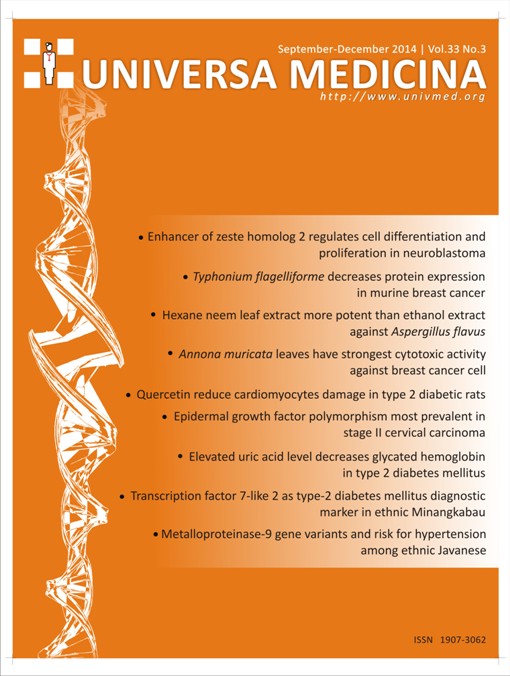Quercetin reduce cardiomyocytes damage in type 2 diabetic rats
Main Article Content
Abstract
Diabetes mellitus (DM) is a group of metabolic diseases which are characterized by hyperglycemia, resulting in various complications. A major macrovascular complication of DM is cardiac failure due to cardiomyopathy. Hyperglycemia
increases oxidative stress, so an oxidative-stress reducing therapeutic agent is required, e.g. the antioxidant quercetin. The aim of this study was to assess the effects of quercetin in reducing damage to cardiomyocytes of type 2 diabetic rats.
METHODS
This research is an experimental study using 40 rats. With simple random
allocation, rats were divided into eight groups, then type 2 diabetes mellitus
was induced using streptozotocin (5 rats per group). The test material was
quercetin given at doses of 5, 20 and 80 mg/kgBW/day orally for 4 weeks.
Each single dose of quercetin was given in combination with glibenclamide 5
mg/ kgBW/day. After 4 weeks the rats were decapitated and the cardiac tissues
taken to quantify the percentage of cell damage after hematoxylin-eosin staining
(HE).
RESULTS
Quercetin at a dose of 80 mg/kgBW/day can lower cardiomyocyte damage
better than quercetin at doses of 5 or 20 mg/kgBW/day. A combination of
quercetin and glibenclamide can significantly lower levels of cardiomyocyte
damage better than quercetin without glibenclamide (p<0.05).
CONCLUSION
Quercetin at a dose of 80 mg/kgBW/day with or without glibenclamide can
lower damage to cardiomyocytes of type 2 diabetic rats. Thus quercetin might
serve as a valuable protective agent in cardiovascular inflammatory diseases
in diabetic rats.
Article Details
Issue
Section
The journal allows the authors to hold the copyright without restrictions and allow the authors to retain publishing rights without restrictions.
How to Cite
References
American Diabetes Association. Diagnosis and classification of diabetes mellitus. Diabetes Care 2012;35:64-71.
Murugesh KV, Yeligar DK, Dash P, Sengupta BC, Maityt TK. Antidiabetic, antioxidant and antihyperlipidemic status of Heliotropium
zeylanicum extract on streptozotocin-induced
diabetic rats. Biol Pharm Bull 2006;29:2202-5.
Perkumpulan Endokrinologi Indonesia
(PERKENI). Konsensus Pengelolaan dan
Pencegahan Diabetes Mellitus Tipe 2 di
Indonesia 2006. PB. PERKENI: Jakarta.
Whiting DR, Guariguata L, Weil C, Shaw J. IDF
diabetes atlas: global estimates of the prevalence
of diabetes for 2011 and 2030. Diabetes Res Clin
Pract 2011;94:311-21.
Karasu C. Glycoxidative stress and
cardiovascular complications in experimentallyinduced
diabetes: effects of antioxidant
treatment. Open Cardiovasc Med J 2010;4:240-
Murarka S, Movahed MR. Diabetic
cardiomyopathy. J Card Fail 2010;16:971-9.
Aguirre L, Arias N, Maraculla MT, Gracia A,
Portillo MP. Beneficial effects of quercetin on
obesity and diabetes. Open Nutraceuticals J
;4:189-98.
Youl E, Bardy G, Magous R. Quercetin
potentiates insulin secretion and protects INS-1
pancreatic â-cells against oxidative damage via
the ERK1/2 pathway. Br J Pharmacol 2010;161:
-814.
David AH. Evaluation of the oral toxicity of
formaldehyde in rats. Univ Med 2008;27:106-
Barik R, Jain S, Qwatra D, Joshi A, Tripathi
GS, Goyal R. Antidiabetic activity of aqueous
root extract of Ichnocarpus frutescens in
streptozotocin-nicotinamide induced type-II
diabetes in rats. Indian J Pharmacol 2008;40:19-
Rabbani SI, Devi K, Khanam S. Protective role
of glibenclamide against nicotinamidestreptozotocin
induced nuclear damage in
diabetic Wistar rats. J Pharmacol Pharmacother
;1:18–23.
Parabathina RK, Raja GV, Rao MN, Rao GS,
Rao KS. Cardioprotective effects of vitamin E,
morin, rutin and quercetin against doxorubicininduced
oxidative stress of rabbits: a biochemical
study. J Chem Pharm Res 2010;2:754-65.
Thent ZC, Lin TS, Das S, Zakaria Z. Histological
changes in the cardiac and the proximal aorta
in experimental diabetic rats fed with Piper
sarmentsoum. Afr J Tradit Complement Altern
Med 2012;9:396-404.
Fineschi V. Cardiac pathology in death from
electrocution. Int J Legal Med 2006;120:79-82.
Lai MH. Antioxidant effects and insulin
resistance improvement of chromium combined
with vitamin C and E supplementation for type
diabetes mellitus. J Clin Biochem Nutr 2008;
:191-8.
Kelly GS. Quercetin. Altern Med Rev 2011;16:
-94.
Kim SH, Jo SH, Kwon YI, Hwang JK. Effects
of onion (Allium cepa L.) extract administration
on intestinal á-glucosidase activities and spikes
in postprandial blood glucose levels in SD rats
model. Int J Mol Sci 2011;12:3757-69.
Erejuwa OO, Sulaiman SA, Wahab MS,
Sirajudeen KNS, Salleh MS, Gurtu S. Effect of
glibenclamide alone versus glibenclamide and
honey on oxidative stress in pancreas of
streptozotocin-induced diabetic rats. Int J Appl
Res Nat Prod 2011;4:1-10.
Mahesh T, Menon VP. Quercetin alleviates
oxidative stress in streptozotocin-induced
diabetic rats. Phytother Res 2004;18:123–7.
Moskaug JO, Carlsen H, Myhrstad M, Blomhoff
R. Molecular imaging of the biological effects
of quercetin and quercetin-rich foods. Mech
Ageing Dev 2004;125:315-24.


